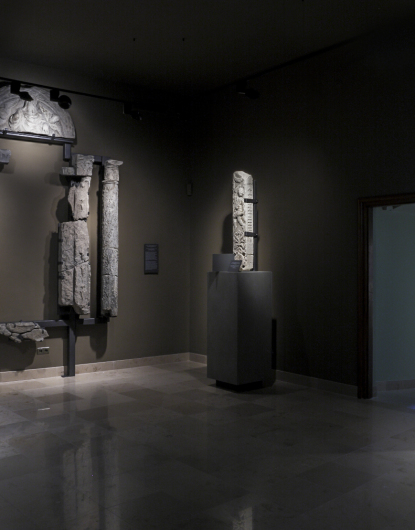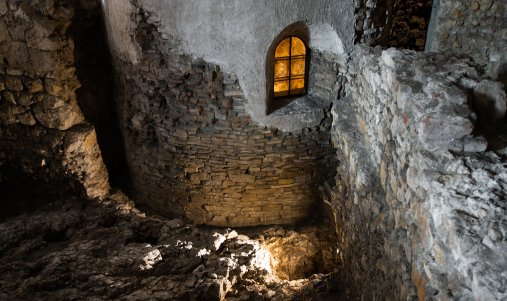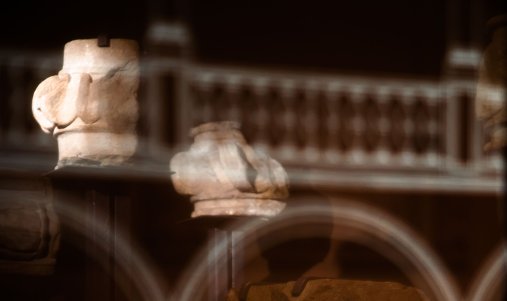The Lost Wawel
The Lost Wawel exhibition in its present form opened in 1975. Building upon earlier expositions dedicated to the history of Wawel Hill and centered on the remains of the Rotunda of Sts. Felix and Adauctus (alternately, Rotunda of the Blessed Virgin Mary) from the late 10th/early 11th century, the exhibition also encompasses the former royal kitchens and coach house. This unique exhibition combines an archaeological-archite ctural reserve, architectural elements from various periods, traditionally displayed objects uncovered in archaeological excavations, and scale models of buildings. One room is devoted to the Wawel’s large collection of Renaissance tiles.
TiIe Room

The 16th–17th century tiles in the collection come from ceramic heating stoves once found in the royal castle. It is the most valuable ensemble of its kind in Poland. The tiles are beautifully decorated with figural elements, vegetal and animal motifs, and coats of arms. Models of tile stoves are also on view.

Architectural details from the Arcaded Courtyard, which was restored by Zygmunt Hendel in 1905–1914. Original 16th-century stonework elements, later replaced by copies, constitute a large portion of the Wawel lapidarium.

The Wawel lapidarium is a collection of stone sculptures and architectural details r ecovered over the past 100 years in the course of restoration work and archaeological excavations. All of the objects relate to the Wawel and were removed from their original locations at different times and in varying circumstances. A selection of the finest stonework is on view in several dedicated rooms. The sculptures and carved stone elements presented are not only parts of an architectural ensemble. They are a tangible manifestation of the fate and transformation of the historic buildings on Wawel Hill. The objects are arranged in thematic groups: architectural elem ents from the Arcaded Courtyard; fragments of stonework from the façade of the royal palace and pieces uncovered in archaeological excavations conducted on the lower terrace of the royal gardens; and sculpture and stonework from the Wawel Cathedral. The Cathedral’s Sigismund Chapel is one of the finest examples of Italian Renaissance architecture north of the Alps, but can only be viewed through a bronze grille. A display of plaster casts of the Chapel’s carved stone decoration provides a unique opportunity to see these splendid ornamental details close up.

Stonework fragments from the royal palace and ensembles of carved stone details found in archaeological excavations of the lower terrace of the royal gardens.

Stonework from the Wawel Cathedral includes a Renaissance altar ensemble from 1521, carved by stonecutters from the workshop responsible the Sigismund Chapel; a tympanum from the tomb (1613–1615) of Piotr Tylicki, bishop of Krakow; and a 1558 marble sculpture of St. Anthony Abbot.

Exhibition of plaster casts of the carved decoration of the Sigismund Chapel. The oldest were cast in 1868–1874, from molds made by the Krakow sculptor Parys Filippi. The casts were made by students attending Courses for Women at the Museum of Technology and Industry in Krakow and published in an 1878 album on the architectural decoration of the chapel entitled “Album ozdób z kaplicy Zygmuntowskiej.”
Rotunda of Sts. Felix and Adauctus

Rotunda of Sts. Felix and Adauctus Archaeological-architectural reserve around the Rotunda of Sts. Felix and Adauctus (or Rotunda of the Blessed Virgin Mary), 10th/11th century. This is the most important architectural site within the reserve. It was excavated and reconstructed in 1917–1918. The cylindrical rotunda with four apses is built directly on limestone bedrock. In addition, on the south side there is a circular annex connected to the main structure by a passageway. The building is constructed of irregular sandstone plate bound with lime mortar. The extant walls of the structure are 3 to 7 meters high (southeast apse). The rotunda was discovered Adolf Szyszko-Bohusz, who also studied the structure and proposed the first spatial reconstruction of the body of the building (model on view in the exhibition).

Royal Coach House Objects discovered in archaeological excavations on Wawel Hill are displayed in the chambers of the former coach house. Material traces of everyday life in the Middle Ages, such as shoes, buckles, pots, and tools among others, are grouped together by their constituent materials. Plaster casts and architectural details which correspond to models of medieval buildings provide context. One of the most intriguing objects on view is a tomb slab carved with an image of the Tree of Life. It comes from a bi-apsidal pre-Romanesque rotunda (known as church B).
Small Kitchen

Small Kitchen Parts of the 16th-century royal kitchens are preserved in this chamber: foundations of the pillars that supported stove hoods, remnants of ovens, and the original ceramic tile floor. Late medieval ceramics, such as kitchen vessels, tableware, floor and stove tiles, are displayed in glass cases. Also on view are models of the 15th-century psalm singers house founded by Jan Długosz and the 14th-century Gothic cathedral.


